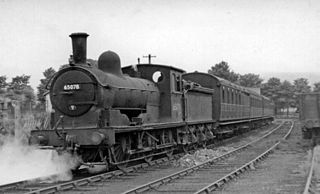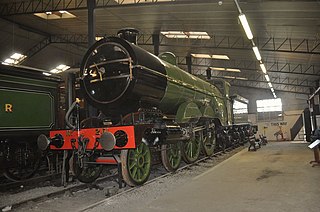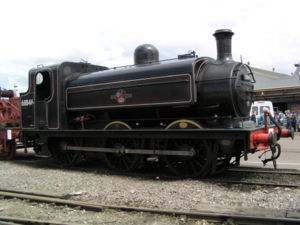
The Great Central Railway (GCR) Class 8K 2-8-0 is a class of steam locomotive designed for heavy freight. Introduced in 1911, and designed by John G. Robinson, 126 were built for the GCR prior to the First World War. Including wartime construction for the British Army ROD and the post-war GCR Class 8M, the class and its derivatives totalled 666 locomotives.

The Great Northern Railway (GNR) Small Boiler Class C1 is a class of steam locomotive, the first 4-4-2 or Atlantic type in Great Britain. They were designed by Henry Ivatt in 1897. In total 22 were built between 1898 and 1903 at Doncaster Works. The class were commonly known as 'Klondykes' [sic], after the 1897 Klondike gold rush. They could reach speeds of up to 90 mph. They were also known as Small Atlantics.

The NBR C Class is a class of 0-6-0 steam locomotives designed by Matthew Holmes for freight work on the North British Railway (NBR). They were introduced in 1888 with inside cylinders and Stephenson valve gear. A total of 168 locomotives was built, of which 123 came into British Railways ownership at nationalisation in 1948. This was the last class of steam engine in service in Scotland.

The GER Class S56 was a class of 0-6-0T steams designed by James Holden for the Great Eastern Railway. Together with some rebuilt examples of GER Class R24, they passed to the London and North Eastern Railway at the grouping in 1923, and received the LNER classification J69.

The North Eastern Railway (NER) Class C1, was a class of 0-6-0 freight locomotives designed by T.W. Worsdell. They were used throughout the NER system, although particularly in Teesside between 1886 and 1962.

The Great Northern Railway 521 Class was a class of 0-6-0 steam locomotives, introduced in 1911. They were designed by Henry Ivatt for goods traffic. From 1912 to 1922 further examples, slightly modified by Nigel Gresley, were built and designated 536 Class. The most obvious difference was in the front sandboxes. These were below the running plate on the 521 but above it, and merged with the front splashers, on the 536. The boiler and firebox were also moved back, thus resulting in a shortened cab. The London and North Eastern Railway classified them both as J6.

The Great Northern Railway Class H4 was a class of 2-6-0 steam locomotive designed for mixed-traffic work.

The Great Northern Railway Class J23 was a class of 0-6-0T steam locomotive. They had long side tanks that came to the front of the smokebox, which sloped forwards to improve visibility and had a recess cut in to aid maintenance. Forty were built by the Great Northern Railway (GNR) between 1913 and 1922, with a further 62 being added by the London and North Eastern Railway (LNER) between 1924 and 1939. They were given the nickname "Submarines" due to their long tanks.

The GER Class L77, LNER Class N7, is a class of 0-6-2T steam locomotives. They were designed by Alfred John Hill of the Great Eastern Railway and introduced in 1915. The design was perpetuated by Nigel Gresley of the LNER after the 1923 grouping. 134 were built and one example is preserved.

The Great Northern Railway (GNR) Class N2 is an 0-6-2T side tank steam locomotive designed by Nigel Gresley and introduced in 1920. Further batches were built by the London and North Eastern Railway from 1925. They had superheaters and piston valves driven by Stephenson valve gear.

The Great Northern Railway (GNR) Class C1 is a type of 4-4-2 steam locomotive. One, ex GNR 251, later LNER 2800, survives in preservation. Much like their small boiler cousins, they were capable of reaching speeds of up to 90 mph (145 km/h). They were also known as Large Atlantics.

The Great Northern Railway (GNR) Class O2 was a class of three-cylinder 2-8-0 steam locomotives designed by Nigel Gresley for freight work and built by the GNR from 1921. Further examples were built by the London and North Eastern Railway (LNER) from 1924.

The Great Northern Railway Class H2 and H3 was a class of 2-6-0 steam locomotive designed for mixed-traffic work.
The London and North Eastern Railway (LNER) operated various classes steam locomotives with a 4-6-2 wheel arrangement. The LNER operated more pacifics than any other of the Big Four British railway companies, and they were mostly used for express passenger work along the East Coast Main Line, though later in their lives many were displaced to other lines.

The Great Northern Railway (GNR) Class L1 was a 0-8-2T side tank steam locomotive designed by Henry Ivatt. It was originally designed for suburban passenger traffic on the Metropolitan City Lines.

The Great Northern Railway (GNR) Class N1 was an 0-6-2T side tank steam locomotive designed by Henry Ivatt and introduced in 1906. They were all withdrawn from service between 1947 and 1959. None have survived.

The GER Class G69 was a class of twenty 2-4-2T steam locomotives built by for the Great Eastern Railway by S. D. Holden in 1911–12 following the design of two rebuilt examples of the GER Class M15 designed by James Holden, his father, in 1904. They all passed to the London and North Eastern Railway at the 1923 grouping and received the classification F6.

The Great Northern Railway J4 Class was a class of 322 0-6-0 steam locomotives, introduced in 1882 designed by Patrick Stirling for goods traffic. Just over half of these were rebuilt by Nigel Gresley to a design by Henry Ivatt between 1912 and 1929.
The GNR Classes D2 and D3 were two classes of 51 4-4-0 steam locomotives designed by Henry Ivatt for the Great Northern Railway (GNR). They were the first 4-4-0s to be introduced by the GNR, and Ivatt's first original design for the railway as well.
The Great Northern Railway J14 later Classified as J53 under LNER service was a 0-6-0 saddle tank steam locomotive class of 52 built between 1892 and 1897.
This page is based on this
Wikipedia article Text is available under the
CC BY-SA 4.0 license; additional terms may apply.
Images, videos and audio are available under their respective licenses.

















